Fall on the Farm
- Rosa
- Nov 10, 2022
- 8 min read

A New Pen for the Chickens
The big project for late October was to move our chickens onto our flower garden. This plot of garden- our largest one- has held all of our flowers for the past few years. This year, it became too over-run with weeds for us to realistically weed it by hand, so we decided to combine our two chicken flocks into one and let them scratch up the garden over the winter. While this would save us the labor (and tedium) of weeding, it did mean we had a lot of a different kind of labor ahead of us.
The first frost of the year hit in mid-October, officially ending the flower season for us. We left the flower plants in their beds; they'll be great food and cover for the chickens. Then we got started building a fence. The first step was to measure out a perimeter around the flower garden, and set marking stakes. Next, we had to drive t-posts with a post driver, into hard clay, of course. This step took a while (and for the taller poles we all had to use a step stool), but eventually there were poles around the whole garden.
Next, we attached the chicken wire. We used zip ties to connect the wire to the poles, and used stakes with hooks to secure the wire to the ground.

Next, we had to build the chickens' roosting houses. Our preferred method for this is to build 'hoop houses' using cattle panels. This is a relatively fast and inexpensive way to build a good size chicken house, which is helpful for us, since we often move our chickens to new areas. In this run, we needed two houses, since we were combining two flocks and wanted to make sure they had plenty of roost space. My dad built the wooden frames, and then we helped bend and connect the cattle panels into place. Next, we used an old billboard as tarps to cover the frames, and connected them to the panels with zip ties (they're very helpful!). Then, my dad built roosts inside each house using 2x4 lumber.
The roosts are just where the chickens sleep at night, so we also gave them a house for egg laying boxes. We have a trailer that was a whole chicken house when we had fewer chickens, but that has since been sitting next to our garden, acting as a tool shed. We moved the tools out and wheeled it twenty feet to its new home in the chicken run, and moved in extra laying boxes to complement the built-in boxes. We just had a few details left after that to ready the pen. We used row covers to protect some perennial flowers in the garden that we didn't want the chickens scratching up, and we put some fencing up around the eucalyptus so they wouldn't scratch at the roots.
Moving the Chickens
Finally, it was time to move the chickens into their new home! Because this is a rather involved process, none of us remembered to get any pictures of actually moving the chickens, except for these two pictures of the final hen to be put into the new pen.
So, I'll just paint you a vivid mental image instead. It was the hottest day of November, the un-seasonally warm sun raising the temp all the way to 80 degrees. We started in the pen of our smaller flock, knowing they'd be easier to catch (they have less wild personalities). First, we set up a temporary fence to limit their space to about a quarter of their run, and then as best we could we corralled the flock into the smaller space. The first ten or so chickens didn't require any chasing; we could just quickly reach down and grab them. Then they started to catch on, and some teamwork was required to corner them and scoop them up.
We loaded about 5 chickens at a time into a temporary cage, and then put the cage in a cart we pulled with the lawnmower, and drove it over to the new pen. This process of catch and release was definitely a four person job, and we got lots of help from my aunt, Suzanne.
The flock in the bigger chicken run was more mixed, and there were some speedy and wily chickens in there. But finally, using the mobile fence and working together, we got all those chickens - and our duck - moved to the new run, too.
We moved over the food and water from both old runs to the new pen, and then the final touch was to run electric wire around the whole bottom of the fence, to keep out any potential predators.
Even after we'd chased and caught them, the chickens were still trusting enough to come see what we were up to. We snapped on the bracers and ran the wire, and then hooked it up to its solar-paneled base, and we were done!
After an eventful morning, finally all of our of chickens were in! In total, we have about ninety chickens. Now came the lovely part - getting to watch them explore their new run. This area is bigger than the areas each flock came from, and has lots of things to scratch and eat.
The chickens got started almost right away on the job we hired them for - scratching up the weeds in the garden! They have very effective feet for raking up the earth. They'll scratch, lean down and peck up any tiny creatures, insects, seeds, and vegetation they see, and then scratch again.
Our duck, Ducky, also liked his new home. He minded his own business as the merged flocks squabbled and vied for the best patches of dirt.
Comfrey Borders
The chicken project was just one of the many projects we worked on as fall came. We also wanted to create of border of comfrey plants around the whole flower garden. Comfrey is a very easily divisible plant, and we wanted to move the plants in the new chicken pen out of it. So we prepped the borders with a thick layer of mulch to suppress weeds, and then dug lots and lots of holes. Since we were planting into clay, we added some compost to the holes as we transplanted.
The comfrey leaves may die back for now, but the chunks of roots will survive and sprout a whole new plant by spring. The comfrey plants will work with the mulch to create a weed-free edge to our garden, so we aren't always on the defensive against the Bermuda grass creeping in. Also, we will have an excellent supply of the leaves, which we use to make "comfrey tea," a liquid fertilizer.
Fall Transplanting
There were other perennial plants in the soon-to-be chicken run that needed to be moved, including dahlias, irises, and yarrow. We divided the irises and yarrow and moved them into the current flower garden, where the overwintering flowers are. There were lots of extras, so we added a strip of both alongside one of the old chicken runs, to attract pollinators when it becomes a veggie garden in the spring.
Our dahlias we marked with flags and then cut down, leaving just a little bit of stem. After they'd been hit once with light frost, we dug them up and cleaned all the dirt off of them. When they were dry, we stored them in brown paper bags surrounded by cedar chips. This will keep them preserved until we plant them again in spring.
Overwintering Flowers
The garden our chickens moved onto is going to be just half of our flowers going forward; the plot attached to it, which was previously vegetables, now holds all the flowers we are overwintering to bloom in the spring. The flowers include snapdragons, bachelor buttons, and poppies.
Although there was a early frost in mid-October, after that point the weather warmed back up, and well into November the weather has still been balmy. This has meant that the flowers are growing well; as you can see from the first two pictures below, the sweet peas have been prospering.
But in some cases, the flowers may be growing a little too well. The snapdragons in particular are ahead of schedule. Ideally, they would not be blooming for another 5 months. It's good for the plants to get strong in the fall and then continue to grow slowly in the colder months, strengthening their root systems but not growing in plant size too much. One of the problems with periods of strong plant growth is that the plants outgrow the row covers. When they press up against the inside of the covers, they are more likely to get frost damage on their foliage.
In the end, there's only so much we can do about the weather. For now, we will cut back the tallest snapdragon spires and re-cover all the plants as frost sets in, and see what winter and spring bring.
Planting Garlic
Once the vegetables were cleared out of smallest vegetable garden, it was time to plant the garlic. This year we're growing several types of hardneck garlic. We separated the garlic heads into the individual cloves, which will each turn into their own head of garlic by the time they are harvested next June or July. Then we prepped the garden beds and planted the cloves, and covered them all with a thick layer of leaves to keep them warm.
Fall Veggie Garden
Because of the shuffling in the gardens this year, we weren't able to plant as many fall vegetables as we will be able to next year. But that does mean we can now take our time clearing out and cleaning up the current vegetable garden. It does have collards, kale, onions, lettuce, and beets in it right now, which could all make it through the winter with the help of row covers. I snuck in another sowing of onions, since the weather has been so warm - hopefully they'll germinate soon.
The summer crop plants are still in the ground in most of the other beds. It's beneficial to have roots in the ground and plants covering our soil, so even though the peppers, beans, and okras stopped producing as the weather cooled, we left them in place. Now, when we have the time, we chop down the plants, leaving the roots in place, and give the vegetation to either the goats or the chickens. Then we shape up the beds, cover them in a thick layer of leaves to rest until spring, and add some new mulch into the paths.
The row of lettuce in this vegetable garden has been growing excellently in the mild fall weather. I planted three types of leaf lettuce, and when I sowed them I had forgotten what color each one was. I'm very glad they turned out to be in color order!
Along with harvesting lettuce, collards, and kale, we also had a fun harvest of horned melon. We had a little plot of land where we'd planted some sweet potatoes, that ended up getting eaten by deer. Instead, a spiny mystery vine took over, which turned out to be a horned melon! The soil came from a compost pile we had, so there must have been a seed that survived and saw its chance to grow.
Farm Cats
Bagheera is enjoying the last of the warm weather. In the winter he won't want to commute to the farm as often; he tends to hunker down. Our old family cat also follows us around sometimes to the gardens, and then falls asleep instantly wherever she is.
Looking Up
The day we moved the chickens was sunny and warm. But as we were finishing up and making sure everything was in place, clouds were gathering on the horizon. Rosa, Concetta, and I sat and watched our chickens happily scratch away as the storm rolled overhead, casting Six Mile Mountain and our farm in contrasting dark blue shadows and lovely gold light. When the rain came, we took shelter in the old chicken hoop house, now empty of any residents. The two pens the chickens came out of will become gardens by spring, and they will be weed free and well fertilized, ready to grow nutritious vegetables. For now, colder weather is coming, and while we still have some plants and plenty of outdoor projects to complete, we are also shifting to organizing and planning for the coming year. I can't wait for the changes that are rolling in!

Thanks for reading,
Lillian






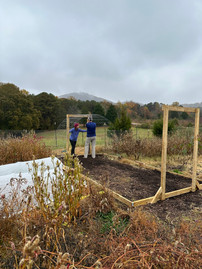



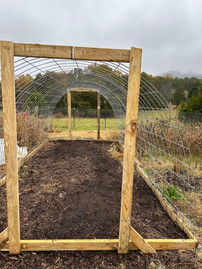







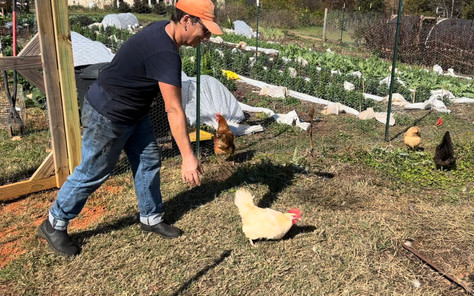

















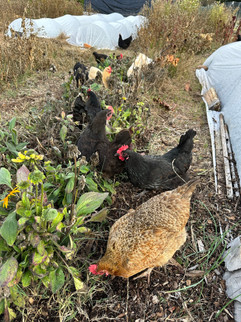







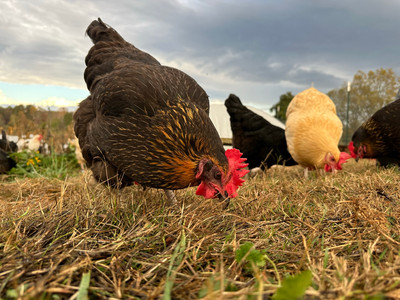



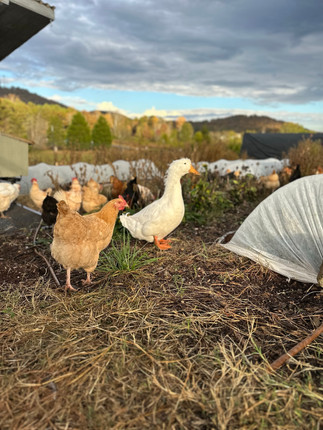

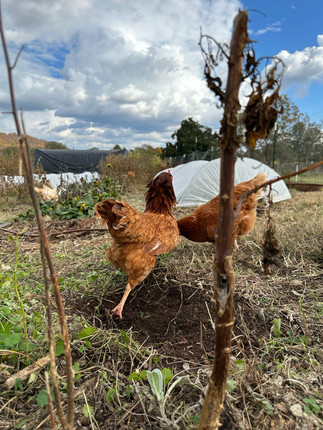























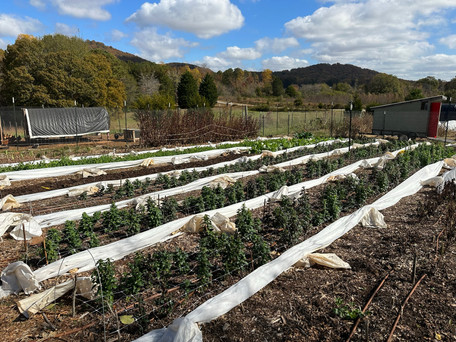



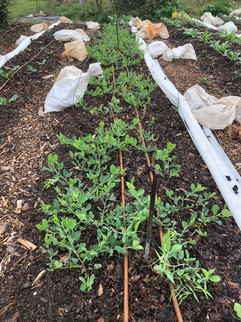

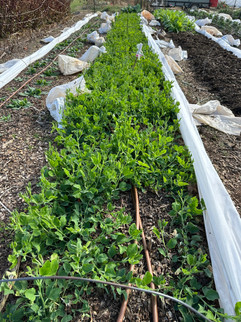

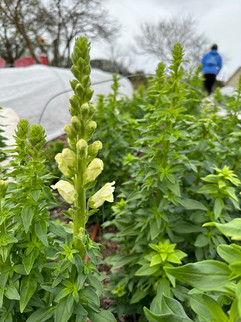









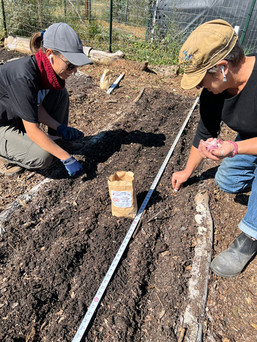













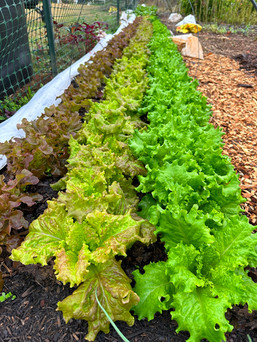















Comments